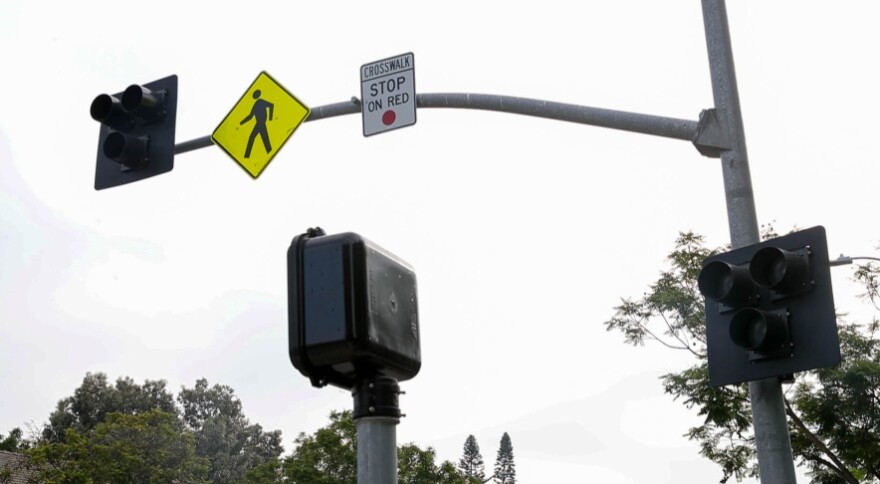Truth matters. Community matters. Your support makes both possible. LAist is one of the few places where news remains independent and free from political and corporate influence. Stand up for truth and for LAist. Make your year-end tax-deductible gift now.
This Crosswalk Signal Is Expected To Make LA Streets Safer For Pedestrians

A new pedestrian crossing system was unveiled Wednesday, the first of its kind in Los Angeles. City officials say it will save lives and plan to install more on L.A. streets.
A HAWK beacon, short for "High-intensity Activated crossWalK," is now in place on 6th Street near Spaulding Avenue in the Miracle Mile neighborhood.
"There have been far too many accidents on this stretch of Sixth Street, which connects residential areas like Park La Brea to L.A. icons like LACMA and the La Brea Tar Pits," City Councilman David Ryu said in a statement. "That is why we have been implementing many data-driven solutions that reduce the rate of accidents and save lives up and down Sixth Street."
HAWK Beacons (also called a Pedestrian Hybrid Crossing) reduce pedestrian accidents by 69%! #VisionZero pic.twitter.com/2YHZb4c2cM
— David E. Ryu (@davideryu) September 25, 2019
That stretch of roadway is part of the city's High-Injury Network -- a 6%-portion of L.A. streets that account for 70% of pedestrian deaths and severe injuries. According to city data, two pedestrians and a bicyclist have been killed on that section of 6th Street since 2012.
The HAWK beacon uses a three-light yellow and red system, which is activated when a pedestrian pushes the button to cross.

First a yellow light flashes to alert motorists to slow down before remaining steady, like a typical yellow light.
Then, twin red lights remain on as pedestrians enter the crosswalk on a timer.
As the crossing time winds down, the red lights flash off and on, then go dark, allowing cars to drive on through.
The system was first designed in Tucson, Ariz. in the late 1990s, based on already existing European pedestrian signals. A 2010 study by the Federal Highway Administration found the beacons can reduce vehicle vs. pedestrian crashes by 69% and overall traffic crashes by 29%.
Those are important statistics as the city grapples with a dramatic spike in pedestrian deaths in recent years.
According to preliminary city data, nearly 880 people have been killed while walking L.A. streets from 2010 through 2018. Pedestrian deaths have exceeded motor vehicle deaths on city streets every year in that period.
An LADOT official previously told LAist the city is bracing for another "tough year" of traffic deaths and that they're "not seeing the kinds of declines that we want to see."
Though this initial HAWK beacon was enacted through a separate street signal program, the city plans to install more of them through its Vision Zero initiative, which aims to eliminate all traffic deaths in L.A. by 2025.

"HAWKs are now either the default or an option to install at all future, new crosswalks without signals, depending on the type of street and the usage of the street," LADOT spokeswoman Nora Frost told LAist. "Existing uncontrolled crosswalks will be eligible for this upgraded standard."
You can learn more about the city's traffic safety projects through LADOT's Livable Streets website.







